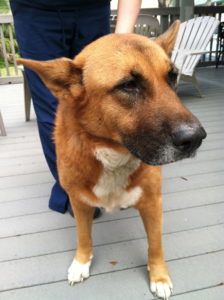 Euthanasia has been on my mind a lot lately. This year we have said goodbye to so many of our most beloved patients, it seems like the end of an era. I am at the point where I am saying goodbye to dogs I have known as puppies. One of the hardest things for all the members of our staff is seeing our clients try to ‘keep it together’ in our office while they undergo this most emotional of experiences. The phrase we most frequently hear in this moment is, “I was hoping she would just die a natural death.”
Euthanasia has been on my mind a lot lately. This year we have said goodbye to so many of our most beloved patients, it seems like the end of an era. I am at the point where I am saying goodbye to dogs I have known as puppies. One of the hardest things for all the members of our staff is seeing our clients try to ‘keep it together’ in our office while they undergo this most emotional of experiences. The phrase we most frequently hear in this moment is, “I was hoping she would just die a natural death.”
Many times, we hear this when the patient in front of us is laterally recumbent, panting, pale, and skeletal. Owners know that their pets look and probably feel awful. One thing I have told unknown numbers of clients over the years in this situation: we almost never see pets for an appointment like this too early. Here’s the deal, as I see it:
Our pet animals do not lead a natural life.
We have selectively bred dogs for a variety of unnatural qualities, like short, twisted tails, squat, compact bodies, muzzles that barely protrude from the skull, bulging eyes, flopping ears. We have bred dogs the size of teacups and dogs the size of small horses. Dogs turn out to have very plastic genes. Cats maybe not so much, but witness Persians, Scottish Folds, Devon Rex, Munchkins, Siamese—there is plenty of variation, if not as much in size.
We have domesticated them, and provide them with food and shelter not always available in the wild. We give them medical care to address common (and fatal) diseases, treat them when they are sick, brush their teeth (well, some of us do) or allow their veterinarian to perform dentistry procedures to remove excessive bacterial deposits in the mouth or abscessed teeth, we give them joint supplements and medicated shampoos. Some of us even provide acupuncture and therapeutic laser treatments. Consequently, our pets live far beyond an age that could be reasonably expected in the wild (I like to imagine packs of wild Shih Tzus when I say this).
One question this begs is: what do we mean when we talk about a natural death? Are we thinking of dying from the effects of disease, or starvation, or exposure, or being killed in a territorial fight with another animal? This is a common collection of natural deaths. No, in our minds, a natural death means curling up quietly on a pillow, drifting off to sleep, and never waking up. And once in a great while, this is what happens. Most of the time though, the story is quite different.
We diagnose many geriatric pets with diseases, in some cases metabolic diseases, such as diabetes, Cushing’s disease, hypo- or hyperthyroidism, and in other cases, cancerous or benign tumors. If you live long enough, chances are, you’ll have one or more of these types of diagnoses yourself. Few people die peacefully in their sleep at home of ‘old age.’ Why do we assume it will be different for our companion animals?
In my experience, many people are blissfully ignorant of the realities of the final stages of terminal disease processes. I consider this a perk of living as we do in a first-world country, where we have access to wonderful health care and where disease and dying are largely hidden from us. Unless you have watched a family member suffer through a terminal disease, or have had a previous pet with the same issue, you are unlikely to truly understand what those last days are going to look like.
For many animals, the end stages of several types of organ failure and cancers look very similar. It isn’t pretty. The pet is not eating, mentally foggy, and possibly in pain. Muscle wasting takes place, and moving around becomes difficult, even if it is not actively painful (although many older pets have arthritis as well). These pets can be nauseated, an unpleasant way to live. Congestive heart failure causes pets to be drowning in the fluid that builds up in the lungs, or unable to take a breath due to fluid in the chest.
At this point, many of our clients are hoping that their pets will ‘let go’ and pass quietly in their sleep at night. But the actual process of dying can take a long time. At some point, it becomes too hard to watch, or the pet simply stops getting up, or becomes agitated. We receive a number of faxes every week from the emergency clinics around town, letting us know that such-and-such patient presented at 3 a.m. laterally recumbent, taking agonal (dying) breaths, and was euthanized.
This is why we consider it a loving act to be able to spare our animal companions suffering. Death is a natural part of life, but that doesn’t mean that the natural way of death is in any way preferable to humane euthanasia. I personally hope that by the time I am diagnosed with some terminal disease, I will have the option to be euthanized at the time of my choosing!
I have made this pact with my own kitty, who at this time is pushing 16 years old, and starting down the well-trodden path toward renal failure. I have looked into her eyes and told her that I will not let her suffer. I will not let her become a cat skeleton covered in fur who can’t move and is too nauseated to eat, and has to receive so many mLs of fluids a day just to hang onto that tenuous thread of life. I know she doesn’t understand my words, but she knows I love her, and that I will take care of her.
This brings up the other objection many people have to the idea of euthanasia. We hear a lot about how the client isn’t comfortable “playing God” by deciding when Fluffy or Shadow will die. The truth that’s missed here is that you have effectively played God for the entire rest of your pet’s life, by feeding, sheltering, immunizing, and treating for illnesses. Why get right to the point of true suffering, and then stand back and say, it’s in God’s hands now?
For my part, I can’t imagine a God so narrow-minded that he would object to your selfless act of mercy on behalf of your faithful companion. If you want to be biblical about it, we as humans have been granted “dominion over the beasts of the field,” and regardless of how you interpret the ancient Hebrew ‘dominion,’ the responsibility for your pet’s well-being is yours.
‘Natural’ is a loaded word. I think that in this context, we have to take a hard look at what is truly natural, and what isn’t. Truly natural is not always better, despite how we have been conditioned.
